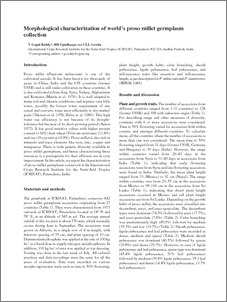Morphological characterization of world's proso millet germplasm collection
Abstract
Proso millet (Panicum miliaceum) is one of the cultivated cereals. It has been known for thousands of years in China, India and the CIS countries (former USSR) and is still under cultivation in these countries. It is also cultivated in Iran, Iraq, Syria, Turkey, Afghanistan and Romania (Martin et al. 1976). It is well adapted to many soil and climatic conditions, and requires very little water, possibly the lowest water requirement of any cereal and converts water most efficiently to dry matter/ grain (Theisen et al. 1978, Hulse et al. 1980). This high water use efficiency is not because of its droughttolerance but because of its short growing period (Arnon 1972). It has good nutritive values with higher protein content (>14%) than wheat (Triticum aestivum) (11.8%) and rice (Oryza sativa) (6.8%). Proso millet is also rich in minerals and trace elements like iron, zinc, copper and manganese. There is wide genetic diversity available in proso millet germplasm, and hence characterizing these resources is a prerequisite for their efficient use in crop improvement. In this article, we report the characterization of proso millet germplasm conserved at the International Crops Research Institute for the Semi-Arid Tropics (ICRISAT), Patancheru, India

